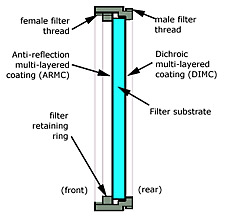Light Pollution Suppression Filter Misconceptions12 November 2012 | Steve Light pollution suppression filters are often the topic for heated discussions among amateur astronomers because of some common misconceptions. Article reproduced courtesy of the Hutech Corporation
Filters make nebulae brighter. This is incorrect. Filters subtract light, making objects dimmer. In the case of filters designed for light pollution suppression, wavelengths from certain types of artificial lights are blocked, but other wavelengths (particular the nebula emission lines) are allowed through, thus improving contrast. This allows longer astrophoto exposures to be made before the sky background begins to wash out the image desired. Visually, the contrast increase may be perceived to be an increase in brightness. Filters make nebulae easier to see. This is true only if properly used. If used in an urban environment, there are often sources of light (including the sky itself) which prevent full dark adaptation of the eye (about 30 minutes in full darkness is normally required). Filters work on all objects. This is not true of all light pollution suppression filters to the same degree. In general, broadband sources (galaxies, clusters, stars, or reflections of stars) will not experience as great a contrast gain as emission line objects. Filters designed for visual use or to select specific narrow emission lines (e.g. OIII) may suppress broad parts of the spectrum, decreasing the light from broadband sources even more than filters designed for balanced colour photography. Filters will block all light pollution. This is not true. Many light sources such as car headlights are still broadband sources and will not be effectively blocked. Filters increase exposure times. While light pollution suppression filters will slightly increase the exposure times of emission line objects in their bandpass and affect broadband sources somewhat more, they do not require increasing the length of an exposure. However, because they increase the contrast of emission line objects compared to the sky background, it is usually desirable to increase exposure times to make better use of the imaging media's dynamic range. Filters cause internal reflections. Interference filters such as the Hutech IDAS LPS filters work by passing virtually all of the selected wavelengths through the filter layer and reflecting all other wavelengths, so they inherently do reflect the rejected light (unlike absorption filters). However, this is not a problem in a high quality telescope with fully multicoated optics (all surfaces, including internal surfaces multicoated) as the reflected components should be passed back out the scope. Low cost optics which typically omit anti-reflection coatings on internal surfaces may reflect enough light from bright objects back into the filter to cause reflections to be visible at wavelengths near the band edges. Reflections from curved optical surfaces in the telescope may also alter filter surface incidence angles enough to shift reflected components into the filter's bandpass. The solutions are to use high quality optics both ahead and behind the filter or, if possible, place the filter as far as allowed from other optical components such as a flattener or compressor.
Some limitations of light pollution suppression filters should also be kept in mind: For photographic use, some colour shift will occur because the filters do not block light in infinitely narrow bands. This affects the ratio of light in the three colour bands being sampled, causing a shift in the perceived colours. The degree to which this occurs may depend not only on the filter being used, but also the type of colour film used. Visually, colour shifts are usually inconsequential since most extended objects will be below the eye's threshold for colour detection. Narrowband filters are tuned to specific wavelengths by carefully controlling the thickness of layers of dielectric material on glass. Because the effective thickness changes when the filter is tilted, the wavelength tuning will also change. In practice, this means that wide-angle views will show a perceptible colour shift between the center and edges of a photo.
|
|
 The IDAS filters themselves are high quality optical elements and are anti-reflection multicoated on the front surface to prevent internal reflections from being a problem.
The IDAS filters themselves are high quality optical elements and are anti-reflection multicoated on the front surface to prevent internal reflections from being a problem. 



